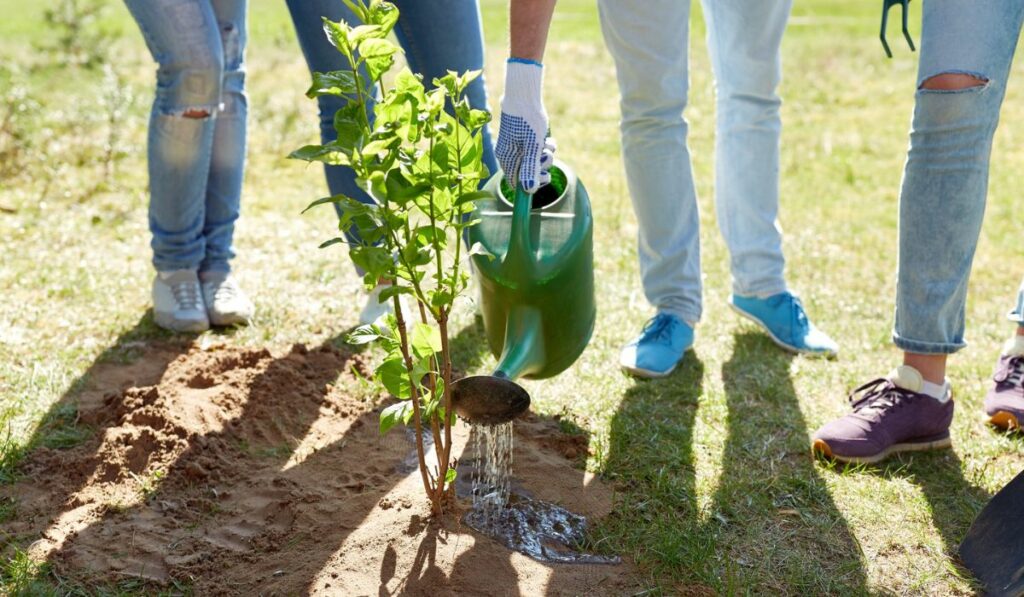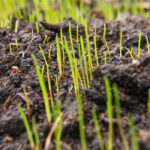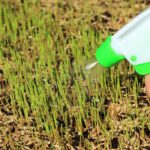The survival and long-term health of newly planted trees primarily depends on how and when they are watered. Root growth and development during the first few years significantly influence how a progresses in life. So, keeping that in mind, how should you water new trees, and how often do they need to be watered?
Water new trees daily for 1-2 weeks, then gradually reduce the frequency to deep watering once every week or two. Irrigate in the late evening or early morning. Use low water pressure to allow for a deep soaking and to prevent runoff. Water needs may vary based on the weather and soil conditions.
Young trees often need water supplementation for up to two growing seasons, and larger species may require water for two or three years. To survive the summer heat and winter cold, the tree you planted will need some TLC. Let’s take a closer look at the best watering practices so that you can raise a happy, healthy tree.
Do New Trees Require More Water Than Established Trees?

Newly planted trees and shrubs have higher water requirements than established trees. They require ample sunlight and water because of their growing root systems and high leaf production.
During the first few years of its existence, a tree establishes its anchoring and feeding root systems below the earth and its trunk and branch structure above the ground.
The faster a young tree can build its root system and put out new leaves for photosynthesis to generate internal energy stores, the more quickly it can grow and survive.
Hot and dry weather might make it challenging for a young tree to absorb enough water to sustain its rapid early development. The lack of water often causes young trees to become stunted and prone to pests or diseases. Under-watering during a heat wave in the summer may even cause death within just days, so be cautious with your new tree!
Start Watering Before Planting
When planting a tree, irrigate the root ball well before moving on to the rest of the soil. When you take your plant out of its container nursery pot (on Amazon) or unwrap its burlap, be sure to hydrate the entire root ball.
The dirt inside the root ball is often dry and compacted, making it difficult for the plant to take up water from the surrounding soil unless it’s wet before planting.
You want to help your new tree adjust to its new environment as effortlessly as possible during the watering.
Water Immediately After Planting
Irrigate a newly planted tree with 2 to 3 gallons of water per inch of trunk diameter. Therefore, 4 to 6 liters of water should be enough when transplanting a tree with a 2-inch-diameter trunk.
Until the tree has established itself, its roots won’t grow past the root ball. The tree’s root ball can’t access moisture below the soil’s surface during this initial growth phase.
When a tree is first planted, its root ball isn’t massive. Therefore, it’s essential to water the soil well around it. A young tree is particularly at risk of dehydration during the sweltering summer heat.
If the soil you’ve placed your young tree in is on the dry side, it’s vital to water it adequately. Where the root ball and native soil meet, the dry ground will naturally take water from the wetter root ball to balance the water distribution, dehydrating the tree.
Watering frequency is even more significant if you’ve planted your young tree near existing trees or shrubs. The roots of the established plants will compete with your new tree’s root system for available moisture and nutrients.
How Many Times Per Week Should You Water a New Tree?
Young trees need one and a half inches to two inches of water weekly. It’s essential to water newly planted trees and shrubs more often than older, more established plants. Provide young trees with water using the schedule below:
- Daily watering for the first two to three weeks after planting
- To keep the soil moist, irrigate every two to three days after the third week
- Water once a week after the first 12 weeks while the roots get established
The amount of water the tree needs will vary depending on size, species, and growing environment. The trunk diameter, or caliper, at planting time can help you determine how much water the tree needs per watering.
Below is a summary of the water amount needed for trees based on trunk size:
| Tree Trunk Caliper | Gallons of Water Per Irrigation | Approximate Root Establishment Time |
| 1 inch | 1 to 1.5 gallons | 1.5 years |
| 2 inches | 2 to 3 gallons | 3 years |
| 3 inches | 3 to 4.5 gallons | 4.5 years |
| 4 inches | 4 to 6 gallons | 6 years |
| 5 inches | 5 to 7.5 gallons | 7.5 years |
Measure your tree’s caliper by measuring the trunk diameter 6 inches above the ground for plants less than 4 inches wide and 12 inches above the ground for more expansive trees.
Where’s the Best Place to Water a New Tree?
Newly planted trees have yet to develop a dense root network. Therefore, they can’t store much water and must be watered frequently. Water young trees near the trunk and root ball for best results.
Ensure that watering is slow and deep through mechanisms such as drip lines. Drip irrigation (on Amazon) helps save water and promotes moisture absorption. Other watering techniques include soaker hoses, sprinklers, and buckets.
Keep the backfill soil wet in the planting hole when transplanting to root growth beyond the root ball. Tree roots grow considerably each year, so expand the watering area over time.
You can create a mini water reservoir by building a circular soil mound at the root ball’s edge around the plant. Fill the reservoir slowly to allow water to penetrate into and around the root ball slowly.
Allowing the soil to dry out completely or to remain damp will stress your young tree and predispose it to diseases and pests. It’s critical to keep the soil continuously moist for healthy trees.
How Long Does It Take New Trees to Become Established?
The establishment phase can range from 3 months to 3 years, depending on the size and when planted. By the end of the establishment period, a tree should have grown enough roots to keep it alive without water supplementation.
Trees grow faster in warmer climates than in cooler climates. During establishment, all trees require regular irrigation, and the primary factors affecting water needs are temperature and rainfall. Ample irrigation encourages rapid root growth into the landscape soil, which promotes quick establishment.
How to Tell If a Plant Is Established

Compare growth rates before and after transplanting to see if a plant is well established. Growth usually slows down right after transplanting and returns to pre-transplantation growth rates when the root system regenerates and post-transplant stress ends.
Water is probably the most limiting aspect after planting. Even if the soil moisture is adequate, the root system may not be able to absorb water quickly enough to meet the plant’s needs.
For the first several weeks following planting, it’s critical to ensure that the root ball moisture levels are correct, as the tree primarily relies on this throughout the first growing season.
Planting new trees in non-compacted, aerated soil encourages the roots to stretch and spread out into lawn or yard soil. Therefore, the trees you buy should have a well-developed root system.








